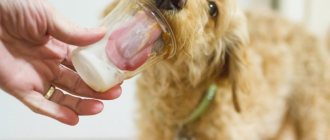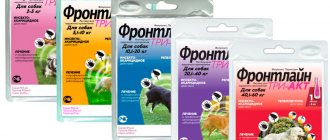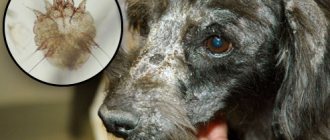Fleas cause severe discomfort to your dog and can cause harm to his body. To destroy them, special preparations are used that must be used correctly. Otherwise, you may harm the animal. There are a large number of flea treatments for dogs available in various forms.
There are many flea treatments for dogs.
Why do dogs get fleas?
Fleas appear in a dog living at home if the pet has had contact with an infected animal or walked in a place where there are parasites . Insects, waiting for prey, sit on plant stems, leaves of bushes, park paths, grass and instantly move to the animal’s fur. The height jump of adults is 3 m, the length jump is 2 m.
A dog will definitely become infected with fleas if it has not been treated with special preparations. Otherwise, the animal is protected from infection not only by these insects, but also by scabies and ixodid mites.
Causes and signs of fleas
Every dog gets fleas from time to time. Even animals living in an apartment are not immune from this scourge. Fleas make jumps up to 30 cm in height and length, which means that you can “pick up” a flea anywhere.
Most often, fleas settle on dogs after the following episodes:
- a walk in the courtyard of the house;
- visiting a park or forest;
- traveling on public transport;
- participation in exhibitions;
- contact with another animal (cat, rabbit, rat, mouse, dog).
People can also bring fleas into the house - on clothes or shoes.
The first sign that your pet has fleas is frequent scratching. In this way, the animal tries to get rid of the annoying insect. The sign of a bite can be detected by parting the fur. A small red spot with a drop of dried blood is clearly visible on the skin.
Symptoms of infection
The main symptoms indicating that a pet is infected with fleas are:
- itching, which causes the dog to constantly scratch;
- hair loss;
- the appearance of small ulcers on the skin in the place where the animal scratches;
- dark balls of feces;
- white clusters of larvae;
- the fleas themselves, which quickly hide in the undercoat.
In addition, the pet may become very anxious, become irritable, lose appetite, begin to sleep poorly, bite sharply into the skin and click its teeth. The dog's eyes often water, and in severe cases, extensive bald patches appear in the croup area, on the withers and at the base of the tail.
Special means for removing insects and rules of use
There are a large number of products that can help rid your dog of fleas. They are intended for large and small breeds, for adult pets and puppies.
Flea drops
The most effective and easy-to-use flea remedies are drops. To achieve a positive result, the drug is applied once to the dog’s withers area. For preventive purposes, the animal is treated once every 2 months. However, the drops have the disadvantage of an excessively high concentration of a toxic substance.
As a result of using the product, the pet develops various negative consequences, so some drops are prohibited for puppies 1-2 months old. But most medications are well tolerated by dogs.
Hartz flea drops for dogs.
Rating of the best products:
- Hartz. The drops contain phenothrin, which kills flea eggs, adults and their larvae. This is the safest drug that is used for puppies of all ages, as well as small breed animals. They are practically not washed off with water, and extremely rarely lead to the development of side effects and allergic reactions.
- Stronghold. This is a complex remedy intended for the treatment of dogs. With its help, adults and larvae are hatched. After the first application, reliable protection of the animal is provided, which lasts 2 months. The drug is approved for lactating bitches and puppies over 1.5 months of age. To get the maximum effect, it is recommended to further treat the dog after 4 weeks.
- Leopard. These are inexpensive drops, but have a large number of side effects. Often, when taking them, excessive salivation, allergies, etc. occur.
Insect killing sprays
Aerosols and sprays are the most effective means to help fight fleas . They are easy to use, and to get results, the drug is applied to the entire body. It is recommended to treat the animal in a well-ventilated room. The death of adult parasites occurs almost immediately after application of the product. The effect of the medicine lasts for several weeks. Frontline and Bars are considered the most effective means.
List of the best drugs:
- Frontline. This is a high-quality and affordable product, the main component of which blocks the functioning of the nervous system of parasites, resulting in paralysis and death. The spray effectively protects against fleas for 3-5 weeks. The drug is approved for the treatment of even small pets that are 2 days old. After treatment, dogs should not be bathed for 2 days.
- Leopard. The spray is applied to the animal's fur, and the main components begin to accumulate in the sebaceous glands, hair follicles, and upper layer of the epidermis, forming a protective barrier against parasites within a month. The drug does not penetrate into the bloodstream. It is contraindicated for pets under 10 weeks of age, pregnant and lactating bitches, weakened and sick dogs.
- Beaphar. This is an insecticidal product that is extremely safe. Despite its slight toxicity, the spray is good at getting rid of blood-sucking parasites. Approved for the treatment of puppies that have reached 2 months of age and small breed dogs.
Using shampoos
Flea shampoos are most often used simultaneously with other antiparasitic agents. Before treatment, the animal is combed and washed. The drug is applied to the entire surface of the body, rubbed until foam appears, after 5 minutes, rinse and dry the hair. When using the product, do not allow it to get into the dog’s ears and eyes. The advantages of shampoos include complete safety, low cost and no side effects.
Shampoo for dogs Phytoelite.
The most popular products:
- Phytoelite. This is a medicinal insecticidal drug that is used externally. It contains the synthetic pyrethroid permethrin, which has a pronounced enteric-contact effect against flea larvae and adults. Thanks to the main component, the neuromuscular transmission of impulses from peripheral nerves is blocked, resulting in impaired coordination of movement, paralysis and death of parasites. It is forbidden to treat puppies under 2 months of age, lactating bitches, sick and weakened animals with the drug.
- Doctor ZOO. The shampoo is made based on natural essential oils. The product has a repellent and insecticidal effect, removes fleas and prevents their appearance in the future. The disadvantages include a short period of validity and not a very convenient method of application.
- Beaphar. The main component has a nerve-paralytic effect, causing rapid paralysis or shock, and subsequently the death of fleas. The particles of the product that remain in the dog’s fur after washing are active for 2 weeks. The drug is prohibited for severe skin lesions, as well as for the treatment of puppies under 6 months and pregnant bitches.
Special collars
Anti-flea collars for dogs are made of plastic. They are presented in the form of a narrow flexible tape with a fastening buckle.
This product has a specific smell because it is saturated with toxic chemicals that repel insects.
The collar works as follows: it is put on the dog, and it heats up under the influence of the animal’s body temperature. After this, the poison begins to be distributed over the pet’s skin and fur, while it penetrates the epidermis and accumulates in the sebaceous glands.
The dog will be completely protected from fleas in 2 days. The required amount of the toxic substance is retained throughout the entire time the collar is worn - about 4 months. The product should not be removed even at night. However, this remedy can lead to the appearance of such negative reactions of the body as lacrimation and drooling, swelling, allergic dermatitis, and severe agitation.
The most popular types of collars:
- Chemical. The tape is impregnated with deltamethrin, a strong insecticidal substance that has an immediate effect on fleas. They are used only for adult animals.
- Biological. Such collars are based on the healing properties of essential oils and medicinal herbs. To enhance the effect, they are used with tablets, aerosols, and drops. They are allowed to be worn by weakened and sick pets, pregnant bitches and puppies.
- Ultrasonic. These products do not have a strong odor and do not contain harmful chemicals, but they are ineffective.
The most common brands: Kiltix, Scalibor, Beaphar Ungezieferband, Foresto.
Flea tablets
Bravecto flea tablets for dogs.
Flea tablets have the following benefits:
- allowed for elderly dogs, pregnant and lactating bitches, puppies from 2 months;
- do not cause side effects;
- have a pleasant smell and taste;
- can be used to treat animals that develop allergic reactions to medications.
The most effective drugs:
- Bravecto. They are produced in chewable form. When it enters the body, the active substance is absorbed into the blood and forms a chemical bond with proteins contained in the blood plasma. When the drug enters the blood of a flea, it has a paralyzing effect on it, as a result of which it dies. All parasites die within 8-11 hours. The effect lasts 3 months.
- Frontline Nexgard. The drug begins to act half an hour after administration. It is effective against 2 types of fleas. The drug is approved from 2 months.
- Comfortis. When using the product, the main component penetrates into the blood. When a flea bites a dog, the poison enters the parasite's body, negatively affecting the nervous system and destroying the intestines. The effect occurs 2-3 hours after taking the tablet. Contraindicated for puppies under 1 month of age.
Combs and brushes
The classic way to rid your pet of fleas is combing. Combs are used as an additional remedy to the main anti-flea drugs. With the help of brushes and combs, the owner rids the pet of parasites by combing them against or along the fur. This method is considered not very effective, but accessible. They resort to it if the dog is not too heavily infected.
The following brushes and combs are available for combing:
- Zoonic;
- Hello Pet;
- TRIOL.
Simparica – protects your puppy from fleas and ticks for 5 weeks
The drug Simparica performed well in studies, and, according to the instructions, is approved for use from 8 weeks, as well as for pregnant and lactating dogs. Simparika is suitable even for the smallest babies, because the minimum weight for taking a tablet is only 1.3 kg. And if you have purchased a medium or large breed puppy, then choosing a dosage for him will also not be difficult. Despite their rapid growth, the effect of simparika is fully enough to provide protection for 5 weeks, and the next dosage can be selected based on the dog’s increased weight. Simparica has an attractive taste for dogs; most puppies perceive the tablet as a treat and eat it on their own. You will not have any difficulty giving the pill.
Folk methods of struggle
If it is not possible to treat your dog with flea medications, you can resort to folk remedies. They are not highly effective, so they are used to prevent infection of the animal. For example, 2-3 drops of any essential oil are applied to the fingers and rubbed into the coat. The strong smell repels fleas. Essential oils of coniferous trees and eucalyptus are most effective.
If the pet lives not in the house, but in a booth, the area around it is treated. To do this, leaves and stems of wormwood, sawdust, and branches of coniferous trees are laid out on the floor and next to the house. To get rid of parasites, you can wash your dog not with shampoo, but with soap based on dust or tar. This method is completely safe, but it has the only drawback - the animal must be treated several times to completely destroy fleas.
For mild damage, use vinegar. It is diluted with warm water in a ratio of 1:3, the wool is washed and left for 15 minutes. Avoid contact of the solution with the eyes and mucous membranes.
Features of treatment for puppies
When choosing a drug that will relieve the problem, you need to take into account the age of the baby. The younger he is, the less aggressive the components in the shampoo or drops should be, so as not to further damage or dry out the baby’s skin. In the first 6-8 weeks of his life, it is better to use simple methods of control; they will not be so effective, but safe for health.
To remove fleas from a puppy, it is important not only to use a special product, but also to clean the room at the same time. If there are other pets in the house, they should also be checked for insects.
Fleas on a 1 month old puppy
For a one-month-old puppy, even the most famous companies do not produce products to combat uninvited guests. You should not buy shampoo for older newborns; it is better to opt for traditional and mechanical methods:
- The first way is to bathe the puppy in a strong decoction of wormwood, tansy, wild rosemary or mint. Be sure to ensure that the drops do not get into the ears, nose and eyes. You need to keep your dog in this bath for at least 15 minutes. If all the offspring are infected, then bathe each puppy separately. After bathing and drying, the coat must be thoroughly combed over white paper or cloth to remove any fallen fleas;
- the second method is similar to the first, only using tar soap, which also has a pungent and repellent odor. First, wet the puppy with water and soap it generously, then freeze in a towel and a warm blanket so that he does not freeze, and hold this “mask” for at least 20 minutes. After this time, thoroughly rinse off the foam along with the dead fleas and do not forget about control combing , as in the previous paragraph;
Active ingredients such as herbs and tar will not harm the baby's skin and will not cause irritation or an allergic reaction, even if the puppy is only 2 weeks old. Therefore, they can be used for two-week-old babies and even newborns. But we must not forget about their mother - the main source of trouble.
Fleas on a 2 month old puppy
At this age, the feeding period has already ended and the offspring already have a more developed immune system, milk teeth and a strong physique. Therefore, it will be easier to exterminate fleas from such a puppy, since long-term preventive measures can be used.
- For this age, companies produce a large number of shampoos, but up to six months it is better to choose drugs with a minimum content of poisons, or better without them at all;
- Now you can buy collars designed for puppies and soaked in essential oils. But such a remedy will be ineffective if there are several puppies in the house due to the fact that they will chew each other’s collars and render them unusable;
- drops on the withers should be used based on the instructions and the age of the baby. Again, this method is suitable for a puppy living separately, since others may get poisoned;
- It is possible to use a spray that allows you to quickly and completely remove parasites, which are again allowed for this age. But, as with other products containing insecticides, they are contraindicated in litter.
Read Signs and treatment of ataxia in dogs: 3 types of disease
That is, if the baby is one of the animals in the house, then all these means are suitable. But if there are two or more of them, then you should be more careful when choosing a flea treatment method.
Fleas on a 3 month old puppy
For dogs of this age, most insecticidal preparations against parasites, which can be easily found in pet stores, are suitable. You can use shampoos and sprays without fear, but again you need to take into account your age. Collars will not be very effective because the puppy has already increased in size and, perhaps, the coat has become longer and thicker.
Preventive actions
It is difficult to prevent fleas from appearing on your pet, but you can reduce the risk of parasite infection several times.
Option for flea treatment for dogs.
To achieve this, the following preventive measures are carried out:
- put on a flea collar before going for a walk;
- Regularly treat the dog's bedding with disinfectants;
- monitor the cleanliness of the animal’s fur and comb it;
- do not allow contact with unfamiliar dogs;
- do not walk the dog in places where there are a lot of fleas (abandoned areas, basements);
- examine the pet after each walk;
- fill the animal's bedding with sawdust, which fleas do not like;
- wash paws and shoes after a walk.
What tablets are given to dogs to prevent tick bites?
The tablets have a preventive effect against parasites, and also destroy existing fleas and ticks. In addition, the product kills internal parasites in the animal’s body.
For preventive purposes in the spring and summer, tablets are given to pets monthly, starting a month before the start of the tick season and ending a month after it ends.
The tablets are available in chewable form and have an attractive aroma and taste for the animal. They can be given to the dog along with food. The main thing is to make sure that the pet chews the tablet completely.
The following remedies are considered the most effective:
- "Bravecto";
- "Frontline NexgarD";
- "NexgarD Spectra";
- "Simparinka";
- "Comfortis".
Room treatment products
To treat a room for fleas, various means are used. Insecticidal preparations in the form of an aerosol are characterized by good penetrating ability. There is no need to pre-dilute them in water, and they allow you to treat a fairly large area. Effective means: Raptor, Dichlorvos, Raid, Combat. With their help, you can rid the room of fleas and their larvae in 1-2 hours.
Concentrates for preparing the solution are used for professional treatment of the premises. A large amount of solution is obtained from one bottle. Such products do not leave stains on fabrics or furniture surfaces and are odorless. These include Biorin, Get, Chlorpyrimac.
You can treat the room with insecticidal preparations in powder form. Scatter them in places that are inaccessible to children and animals. Such products include Fas-Double, Clean House, Phenaxin, Brownie. Thanks to them, you can get rid of fleas in one application.
What means to use to kill fleas and larvae in the external environment?
It is immediately necessary to emphasize one important circumstance: if adult parasites and their larvae in the external environment are not first destroyed, the fight against them will turn into a rather useless undertaking. In addition, in advanced cases, it may turn out that fleas, deprived of the opportunity to attack a protected dog, will begin to intensively “gnaw” the owner of the animal, as well as members of his family.
Important! It must be remembered that the parasites that are visible on the dog’s body make up no more than 23-30% of the entire flea population.
All other fleas (including larvae) live somewhere in the house itself. They love damp and shaded places, ideal for cracks and potholes in flooring, walls, etc. There have been cases when entire “deposits” of flea larvae were discovered under the linoleum in old houses.
The larvae feed on a variety of organic matter, which includes microscopic flakes of skin, feces, and other “goodies.” The less often wet cleaning is carried out in rooms, the more fleas will eventually be in the room.
Using Vinegar
A very simple and cheap product with impressive effectiveness. Of course, you should only use table vinegar of 9% concentration. It is mixed with boiled water in a 1:1 ratio.
Fill any household spray bottle with the resulting mixture and carefully “pouring” it over all the cracks, potholes, and other suspicious places. You will have to do this for three or four days. The treated room is thoroughly ventilated. We note, however, that it will not be possible to completely get rid of the “flavors” of the bite right away.
Tar soap against fleas
Most often, tar soap is used to wash a pet, but it is still wiser to use this product to disinfect the external environment. The fact is that the surface of the skin of dogs is protected by a thin layer of secretion from the skin glands. Soap washes it away too quickly, which leads to undesirable consequences (including dermatitis, dermatoses and eczema).
To destroy fleas and parasite larvae in the external environment, the soap is rubbed on a fine grater and mixed with hot water. Take about ¼ piece per bucket. If the owner does not like the specific smell of tar soap (which, by the way, dissipates rather poorly), then ordinary laundry soap can be used with the same success.
Essential oils
Many essential oils are excellent repellents, and therefore they can and should be used in the fight against fleas. Below we will describe how and what types of them to use for direct treatment of a dog, but for now we will consider the method of “disinfecting” an apartment:
- Oils can simply be dropped into cracks and potholes in both flooring and walls.
- Experienced breeders advise adding them to water for washing floors. It is recommended to add 25 drops of the selected product to one bucket.
- Oils can be mixed with water at the rate of four drops per liter, after which any household spray bottle can be filled with the resulting mixture. It is used to treat the most difficult to reach places in the apartment.
In both cases, the products are extremely effective, allowing you to completely clear the room of adult parasites and larvae in a few weeks.
The danger of dog fleas to humans
Dog fleas can bite a person when they are very hungry. Most often this happens at night.
Parasite bites can pose the following dangers to humans:
- Causes an allergic reaction. Often an allergy develops to the parasite's saliva. This causes swelling, itching, redness, and papules. In some cases, bites provoke psoriasis or eczema.
- They introduce an infection. A bite can transmit dangerous infectious diseases such as helminthiasis, tularemia, brucellosis, typhus, and salmonellosis.
Reviews from pet owners
Elena, 35 years old. Moscow: “When my dog got fleas, the veterinary pharmacy recommended Bars drops. I applied the product once to dry skin in the neck area at the base of the skull and between the shoulder blades so that the animal could not lick it off. For 3 days after this, the pet was not washed. As a result, all the parasites died, and the dog no longer suffered from itching.”
Mikhail, 43 years old, Saratov: “It’s convenient to use a spray to kill fleas on dogs. This drug, unlike drops and tablets, acts quickly, and there is no need to treat the animal again. I find Frontline effective. It quickly helped rid my pet of such parasites. But you need to use it correctly so that the spray does not get into the dog’s respiratory system.”
Source
How dangerous are blood-sucking parasites for humans?
Dog fleas do not live on a person, but they can bite if they are on his body. The most “innocent” consequence is skin irritation at the site of the bite. This is how a local allergic reaction is expressed. If you scratch this wound, there is a risk of causing a so-called “secondary infection.” In this case, the bite site festers, and pathogenic microflora enters the body through the bloodstream. If left untreated, sepsis (blood poisoning) may occur.
A flea can infect humans with the following diseases:
- brucellosis – multiple lesions of the human body systems (cardiac, digestive, motor, reproductive, etc.);
- helminthiasis - parasitic worms that settle in the digestive and other systems of the body;
- encephalitis – brain damage;
- salmonellosis - an acute infection of the gastrointestinal tract;
- tularemia – damage to the lymph nodes and severe intoxication of the body.
Any of the listed diseases caused by fleas from a dog is a serious test for the body and never goes away without consequences.
Parasitic insects can cause a lot of problems for your pet. Flea bites are very irritating to dogs, they become nervous, eat less well and sleep poorly. Scratching flea bites leads to ulcers and hair loss. This disease is called flea dermatitis.
In addition, fleas can infect a dog with the following diseases:
- cucumber tapeworm (dipylidia) is a tapeworm up to 70 cm long that parasitizes the small intestine of an animal. Infection occurs when an animal ingests an infected flea;
- distemper is an infectious disease that affects the mucous membranes and central nervous system of an animal;
- brucellosis;
- anemia (anemia) if the dog has a lot of fleas.
Considering the listed diseases that can result from bites of blood-sucking parasites, the question of how to remove fleas from a dog is very relevant.











